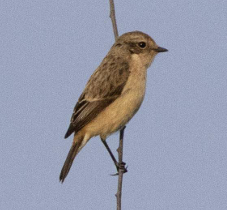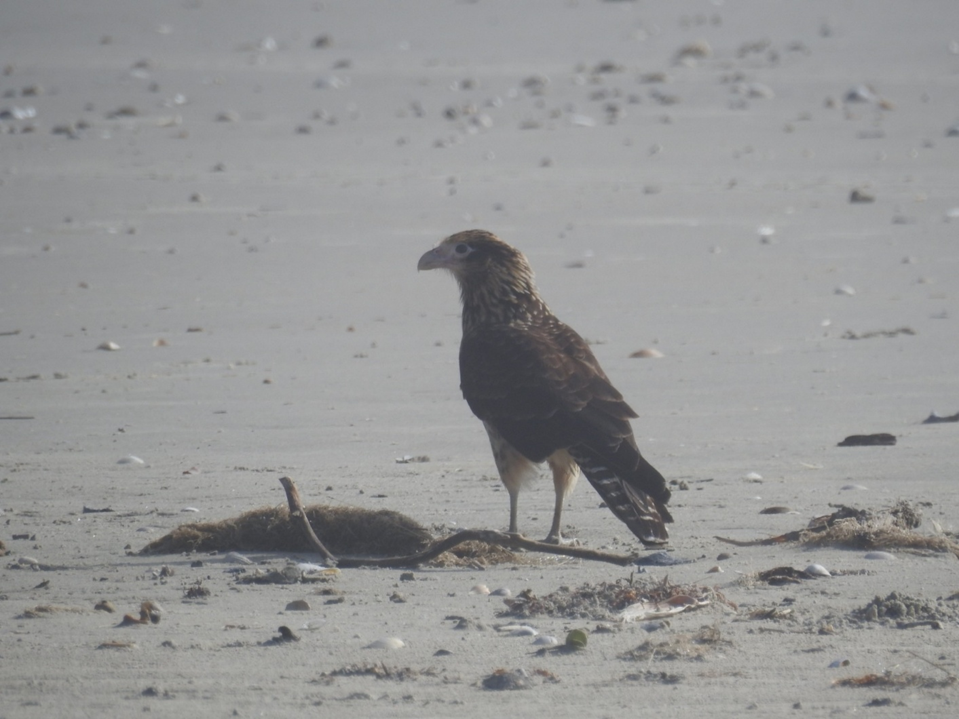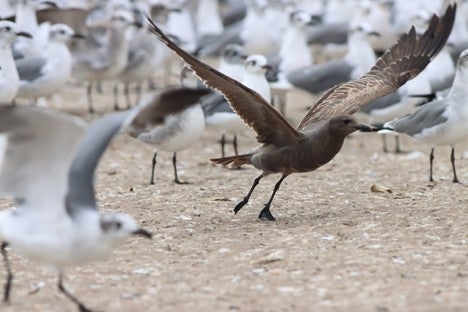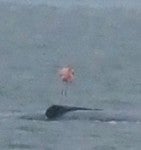
La página que intenta visitar sólo está disponible en inglés. ¡Disculpa!
The page you are about to visit is currently only available in English. Sorry!

I spent my typical 2-weeks prior to the Christmas Bird Counts (CBCs) scouting every day in the Central Coast. My notes indicated weather was mostly mild leading up to the CBC season. Inland areas were dry. Waterfowl and raptors were below average. Most of the waterbirds had left for “wetter pastures”. Sparrows were in small numbers. Migrating passerines in late fall were hard for me to locate. We dodged all hurricanes except for Beryl that passed through the Matagorda to Houston area during summer. Conditions were looking like another average CBC season as I packed my bags for a planned 10 days in a row of CBC Birding knowing that a few quality birds will change the results for the season from Average to Great. A new species for the U.S. CBCs would be a good start.

Amur Stonechat was discovered on the Bolivar Peninsula CBC (1st Texas Record) by David Hanson and David Sarkozi. Photo: David Sarkozi/Christmas Bird Count.
The Texas CBC season started on Saturday 14 December 2024 at 16 CBCs and finished on Saturday 4 January 2025. Those 2 dates were the most frequently used to produce a record 123 CBCs for the season. Longview, Proctor Lake and Wharton Peach were the only registered CBCs not conducted. Texas reported 396 species (+ 3 others in Count Week) which was the most species in 19 years. The 3672 Birder Days was a record for Texas and the 7895 Party-Hours used was average for the past 10 years.
A 2nd species new to the U.S. CBCs would be better.

The Yellow-headed Caracara lingering at Galveston CBC was new for U.S. CBCs. Photo: Greg Whitaker/Christmas Bird Count.

Another stunning find was a Gray Gull amongst Laughing Gulls at Brownsville CBC. The new species for Texas was the 2nd U.S. CBC Record. Photo: Justin LeClaire/Christmas Bird Count.

American Flamingo lingering at West End Galveston Island CBC was a new Texas CBC Record. Photo: Donald Verser/Christmas Bird Count.
Another surprise was a Brown Noddy at Coastal Tip CBC which was a new CBC Record for Texas. Photo: Stephanie Bilodeau/Christmas Bird Count.
Read the rest of the article to learn about more exciting reports from Texas CBCs.
. . . . .
SPECIES TALLIES
Total Species: Twenty of the 123 CBCs had at least 150 species. Matagorda County–Mad Island Marsh led Texas CBCs with 232 species. Guadalupe River Delta-McFaddin Family Ranches was 2nd with 223 and Freeport was 3rd with 197. Jackson-Calhoun CBC had 193 species, Corpus Christi 189, San Bernard N.W.R. 184, Powderhorn 177, Brownsville and West end Galveston Island 171 each, Galveston and Laguna Atascosa N.W.R. 170 each, Corpus Christi (Flour Bluff) and Coastal Tip 169 each, Harlingen 168, Bolivar Peninsula and Weslaco 165 each, Cypress Creek 153, Attwater Prairie Chicken N.W.R. 152, Powderhorn 156, and Brazos Bend 151 species.
Individual Species: Ninety-seven of the 123CBCs had the highest tally of at least one of the 396 species in Texas. Matagorda County-Mad Island Marsh led the State with the highest tally for 41 of those species this season. Guadalupe River Delta had highest tallies for 20 species, Brownsville and Coastal Tip 19, Harlingen 18, El Paso 15, Falcon Dam 13, Brazoria-Columbia Bottomlands and Boliver Peninsula 11 each, and Davis Mountains, Freeport, Galveston, Santa Ana N.W.R. and Weslaco 10 each. All other CBCs had the highest tally for 9 species or less.
RARITIES
Texas reported 51 species which were found only on one of the 123 CBCs. Congratulations are extended to Falcon Dam and S.P. CBC for another banner year of uncommon species. They had Muscovy Duck (2nd decade record), Hook-billed Kite (4th decade record), Mottled Owl (2nd for decade), Brown-crested Flycatcher (7th decade record), 7 Brown Jays (1st for decade) and 7 Bank Swallows (4th decade record).
Matagorda County-Mad Island Marsh had 4 species exclusive to their CBC. Yellow-billed Cuckoo (2nd for decade), Chuck-will’s-widow (3rd decade record), Yellow-throated Vireo (2nd for decade) and Scarlet Tanager (3rd for a Texas CBC).
2nd CBC Record of the Yellow-billed Cuckoo for the Decade at Matagorda County. Photo: Janey Woodley/via eBird.
Two additional species exclusive to Galveston CBC were Bay-breasted Warbler (2nd time in decade) and Orchard Oriole (3rd time in decade). San Bernard N.W.R. CBC Sea Watch was productive. They had the only White-winged Scoters (7th occurrence in decade) and Pomarine Jaeger (6th occurrence in decade). Brazos Bend CBC had the only Glaucous Gull (5th decade record). Brazoria-Columbia Bottomlands CBC had the only American Redstart which was odd in that multiple CBCs usually report it every season.
A MacGillivray’s Warbler was found at Freeport CBC for the 4th record this decade. Photo: David Hornburg/via eBird.
Guadalupe River Delta-McFaddin Family Ranches CBC reported the only Dickcissel (8th record in decade). Spring Creek CBC found members of their resident population of Red-cockaded Woodpeckers for the 10th time this decade. Attwater Prairie Chicken N.W.R. CBC also reported individuals of their resident population of the endangered Prairie Chickens.
The 3rd Texas record of a Grace’s Warbler this decade was at Brownsville CBC. Photo: Saintsgirl/Christmas Bird Count
Corpus Christi-Flour Bluff CBC reported the 3rd record of Thayer’s Gull this decade. Laguna Atascosa N.W.R. CBC reported the only Brown-crested Flycatcher (7th record) and Tennessee Warbler (7th record for decade). Harlingen CBC had the only Bullock’s Oriole (9th record). Brownsville CBC also had the only Grace’s Warbler (3rd record) and Hermit Warbler (2nd record). Coastal Tip CBC had an amazing 22 Wood Storks (8th season) and 1 Purple Gallinule (8th season). Santa Ana N.W.R. CBC had the only Broad-winged Hawk (5th season). Laredo CBC reported the only Greater Pewee (8th season).
The Greater Pewee reported on the Laredo CBC was the 8th report this decade. Photo: Jose Sanchez/Christmas Bird Count.
Pacific Loon at San Antonio CBC was the 9th season for Texas this decade. Mountain Plovers have demonstrated that they can be reliably found at Granger CBC (9 seasons this decade). The first time Chimney/Vaux’s Swifts were reported this decade were at Fort Cavazos CBC where 3 were found.
The 4th Texas CBC Record for a Yellow-billed Loon was photographed at Balmorhea CBC. Photo: Stephen Falick/via eBird.
The Sagebrush (Sage) Sparrow is a regular occurring winter species that was only found at Balmorhea CBC this season. The Williamson’s Sapsucker was only reported at the Davis Mountain’s CBC. The Western Screech-Owl was found for its 8th season this decade at Big Bend N.P. (east) CBC. The Mexican Jay finds the Chisos Mountains CBC to its likings (10 seasons).
The Big Bend Ranch S.P. is a new CBC that during its first season reported the only Gray Vireo (1st record this decade) and Varied Thrush (1st record this decade) in Texas. Both species have been reported less than 10 times on Texas CBCs. We look forward to what will be reported in future years.
El Paso is the far western CBC for Texas. A team of talented birders working it usually produce very good results. This season they reported Broad-billed Hummingbird (reported 8 times this decade) and Yellow-eyed Junco (reported 3 previous times on a Texas CBC). A Berylline Hummingbird which has been found only twice on a U.S. Christmas Bird Count was reported during Count Week.
Fourth Occurrence of a Yellow-eyed Junco on a Texas CBC was at El Paso CBC. Photo: John Groves/Christmas Bird Count.
The only Long-eared Owl was found at Muleshoe N.W.R. Amarillo CBC had the only Golden Eagle (reported every season this decade) and Chestnut-collared Longspurs (9 seasons). Lake Tawakoni CBC reported Smith’s Longspurs for the 8th time this decade.
MISSED
I always do a self-evaluation at the end of a CBC. Did I miss species or were they just not there? Looking at how many species on the count which were represented by one individual might provide an index to the likelihood you Missed species with the higher % indicating species more likely have been missed. As an example, at Houston Central CBC 12% of the 104 species were represented by 1 individual on 16 December and Matagorda County CBC 7% of their 232 species were represented by 1 individual during the same day and similar weather. This index is obviously not perfect but might have some relevance to individual CBCs on whether it is warranted to recruit additional birders.
Texas CBCs this season individually averaged 14% of their species tally being represented by one bird and 10% of the species (40) state-wide were represented by ONE BIRD.
How can we tell if we missed? It is pretty speculative saying we missed unless we have before and after data for the areas surveyed. For “grins” I looked at 97 species which we had during the past decade that was not found this season and tallied how many times they were reported in the decade. Forty-two were only reported once, 15 twice, seven 3-times, four 3-times, five 4-times, six twice, seven 5-times, eight once and none 9 times.
There is a huge number of species potentially in Texas during these CBCs. We had the most (396) species reported in Texas in 19 years. Yet, there were 97 additional species reported in the decade before that were not found. What would it take to produce 493 species, 450, or 425?
THE COUNT SEASON
Austin (96), Westcave Preserve (95) and Matagorda County (91) had the most field birders for Texas.
WEATHER
Most of the State was drought free until fall when rain was hard to come by.
Texas rain dancers, holders of weather charms and focused wishes to the Weather Makers were better than last year. Weather during the counts only hampered 40% of the CBCs for part of the day (fog, rain, <32 - >80oF, wind 21+mph). Freezing temps occurred on 9% with the 22oF at McNary CBC being the coldest. Hottest temperature was 87oF at West Kerr County CBC. Fog occurred on 15% of the counts and rain on 20% of the CBCs with 8 having heavy rain. The Winds 20+ mph occurred on 6% of the counts with the strongest at 38 mph at Harlingen CBC. Weather was mostly reported as pleasant and occasionally too warm. This past winter was again reported as the hottest on record. Mosquitoes became a nuisance along the Coast with the above average temps.
EFFORT
Total CBCs – Three CBCs (Big Bend Ranch S.P., Camp Bullis and Garner S.P.) were new this year bringing our total active CBCs up to 123. Birder-Days – 3672 (highest), Party-Hours – 7895 (average for past 10-years), and Party-Miles – 26,915 (3% below 10-yr average).
My wife, Dora Ann, and I managed to participate in 8 during the 1st 10 days. It was a Great Experience on the Coast being able to participate in many of the CBCs with the highest species numbers. We recommend you try it.
SPECIAL ASPECTS
At the end of each CBC report, there is a section labeled “SPECIAL ASPECTS”. The compiler is provided this space to discuss issues related to their CBC. I read every one.
Compilers from 35 of the 123 CBCs provided some meaningful comments/information in the Special Aspects Section. The main topics were drought in the West, development near urban areas and the occasional bad weather.
POPULATION TRENDS (Where Have All The Birds Gone?)
[Population trend section will compare number of individuals of a species tallied this season to the tallies adjusted for effort from the last 10-years in Texas. Population changes indicated will be for those reports which deviated by more than 1 standard deviation from that species 10-year average unless otherwise indicated. Percent decreasing is underrepresented because missed birds are not part of the % decreased. National avian trend data for > 50 years can be found at (https://www.audubon.org/conservation/where-have-all-birds-gone)].
Table 1. Percentages of species increasing or decreasing by CBC season in Texas.
SEASON INCREASING DECREASING NO CHANGE
109th 19% 16% 65% Hurricane Ike
110th 24% 14% 60% drought
111th 30% 4% 66%
112th 26% 22% 52% drought
113th 19% 24% 57% drought
114th 13% 21% 66% drought
115th 25% 15% 60%
116th 21% 16% 63%
117th 20% 15% 65% warm
118th 17% 20% 63% Hurricane Harvey
119th 15% 27% 58% wet fall
120th 17% 24% 59% dry fall
121st 20% 24% 55% drought
122nd 13% 34% 53% wet summer
123rd 18% 22% 60% drought
124th 17% 20% 63% drought
125th 23% 13% 64% dry fall
Species with increasing populations occurred at >% than those decreasing on Texas CBCs for the 1st time in 8 years. Ninety species (23%) were above the past 10-year average this season.
[Species tallies in this section will be shown in (parenthesis) when a species is discussed.]
GEESE: 6 species stable and 1 decreasing. Cackling Goose at lowest density for decade at 6784.
Black-bellied Whistling-Ducks have established themselves as permanent residents in many places in Texas. Photo: Lisa & LiLi/via eBird.
PUDDLE DUCKS: 8 species stable and 3 below average. Mallard (6363) and Cinnamon Teal (26) at lowest levels in decade.
DIVING DUCKS: 9 species stable, 3 increasing and 3 declining. Black Scoter (177) and Long-tailed Duck (5) at highest, and Common Goldeye (206) were at lowest level for decade.
Lesser Scaup led by a Long-tailed Duck at Guadalupe River Delta CBC. Photo: Tim Forrester/Christmas Bird Count.
UPLAND GAME BIRDS: 6 species stable and Plain Chachalaca below average for 2nd year in a row.
LOONS THRU GREBES: 5 species were stable, Pied-billed Grebe (3031) was at its lowest level for decade and Pacific and Yellow-billed Loon were pleasant surprises at 1 each.
STORK THRU SPOONBILL: It was a good season for this group with only the Roseate Spoonbill (1453) at its lowest level for the decade, 7 species increasing (5 at record levels: 1 American Flamingo, 22 Wood Storks, 10,588 Neotropic Cormorants, 936 Anhingas and 116 Green Herons), and 18 stable.
Swainson’s Hawk is infrequent on Texas CBCs. Photo: Tom Forwood, Jr./Christmas Bird Count.
DIURNAL RAPTORS: 5 species increasing with 4 at record high levels for decade (Black Vulture 23,844; Osprey 1531; Gray Hawk 80; and Red-shouldered Hawk 1553), 7 decreasing with 5 at record low levels (Golden Eagle 1; Northern Harrier 1140; Sharp-shinned Hawk 167; White-tailed Hawk 206; and Red-tailed Hawk 2297) and 7 stable.
RAILS THRU CRANES: 1 species increasing, 4 decreasing and 7 stable. Limpkin (53) completed its 4TH year of which we were aware of its range expansion into Texas and were found at only 10 CBCs which was 2/3 of last seasons numbers. Virginia Rail (85), American Coot (52,880), and Sandhill Crane (12,348) were at their lowest levels in the decade. Whooping Cranes (159) were reported at 6 CBCs.
One Purple Gallinule is typically found each season. This year it was reported at Coastal Tip CBC. Photo: Paul Gonzalez/Christmas Bird Count.
SHOREBIRDS: Have been reported as “The Wind Birds” by Peter Matthiessen in his book “The Shorebirds of North America”. They demonstrate their affinity to move with the wind daily (105,473 shorebirds were tallied in the 123rd season, 207,000 in the 124th and 130,390 in the 125th) chasing food and seeking protection with the changing tides. Two species were increasing, 4 decreasing and 23 stable this season. Black-necked Stilt (3949) and Piping Plover (743) were at their highest levels for the decade, and Willet (2879), Dunlin (2127) and American Woodcock (78) at their lowest.
The Laguna Madre Is A Major Wintering Area For The Western Sandpiper. Photo: Justin LeClaire/Christmas Bird Count.
JAEGER THRU SKIMMER: This group of species continues to have the highest percentage (44%) of species above average. Eight increased, 11 were stable and one decreased. Gray Gull (1; new for Texas CBC), Glaucous Gull (1), Brown Noddy (1; new for Texas CBC), Common Tern (43) and Royal Tern (3664) were reported at record high levels for the decade.
Gulls and Terns resting on the beach at Matagorda County CBC were in above average numbers. Photo: Hank Arnold/Christmas Bird Count.
PIGEONS THRU ANI: Two species increasing, 1 decreasing and 7 stable. Yellow-billed Cuckoo (1) and Greater Roadrunner (311) were reported at their highest level in the decade.
OWLS THRU NIGHTJARS: 4 species increasing, 1 decreasing and 8 stable. Burrowing Owl (114), Mottled Owl (1), and Chuck-will’s-widow (1) had record high tallies for the decade. Milder weather was more conducive to locating night birds at dawn this season.
Which Species is It? Correct Answer is Rufous/Allen’s Hummingbird. My Research in Victoria Indicated about 8% of this type of Hummer on the Texas Coast were Allen’s. We should not Assume that all Selasphorus are Rufous. Photo: Brent Ortego/Christmas Bird Count.
SWIFT THRU HUMMINGBIRDS: Six species increased and 6 were stable. Chaetura spp. (3), Ruby-throated Hummingbird (31), Black-chinned Hummingbird (35) and Allen’s Hummingbird (2) had their highest tally for the decade. Berylline Hummingbird (CW) was reported for the first time for a Texas CBC.
Buff-bellied Hummingbird numbers have declined from an average of 61 per season in the 1st half of the decade to 34 in recent years. Photo: Hank Arnold/Christmas Bird Count.
KINGFISHERS THRU WOODPECKERS: Four species increasing and 12 stable. Williamson’s Sapsucker (8), Red-naped Sapsucker (29) and Northern Flicker (1091) had their highest tally for the decade.
FALCONS: The Yellow-headed Caracara was new to U.S. CBCs as a wild bird. Prairie Falcon (9) was at its lowest level in the decade and 5 other species were stable.
FLYCATCHERS: 8 species increasing and 9 stable with 2 species (Northern Beardless-Tyrannulet and Eastern Wood-Pewee) during Count Week. The Least Flycatcher (33), Western Flycatcher (2), Say’s Phoebe (207), Great Kiskadee (1405) and Tropical Kingbird (305) had their highest tallies for the decade.
Least Flycatcher (33) occurred in record numbers for the decade in Texas. Photo: Mikael Behrens/Christmas Bird Count.
Say’s Phoebe had Its highest tally for the decade at 198. Photo: Bob Friedrichs/Christmas Bird Count.
SHRIKE THRU VIREOS: 2 species increasing, 1 decreasing and 3 stable. Gray Vireo (1) and Yellow-throated Vireo (1) were reported at their highest level in the decade.
CORVIDS: Three species increasing, 1 decreasing and 6 stable. Brown Jay (7) has finally returned to Texas CBCs.
Green Jay (1724) was reported 50% higher than last year. They entertained many people on the eastern side of their range. Photo: Brent Ortego/Christmas Bird Count.
HORNED LARK THRU SWALLOWS: Four species stable, and Bank (7) and Barn (66) Swallows at their highest levels in the decade.
CHICKADEES THRU CREEPER: Seven species stable, 2 species increasing and 1 declining. Black-crested Titmouse (2978) and Brown Creeper (218) at their highest levels during the decade, and Brown-headed Nuthatch (67) at its lowest.
WRENS THRU KINGLETS: Eight species stable, 2 decreasing and 5 increasing. Marsh Wren (607) at its lowest level in the decade, and Carolina Wren (7685) and Bewick’s Wren (1238) at their highest.
Marsh Wren tallies in previous seasons generally averaged about 1000, but They dropped closer to 700 during the last 4 Seasons. Photo: Thomas Johnson/Christmas Bird Count.
Clay-colored Thrush (73) was reported further inland (Guadalupe River Delta, San Antonio East and Uvalde County) than normal. Photo: Ken Butler/via eBird.
BLUEBIRDS THRU THRUSHES: Two species were stable. The Townsend’s Solitaire (2) declined and 4 species increased. Three hard to locate Wood Thrush’s were reported.
CATBIRD THRU MOCKINGBIRD: Long-billed Thrasher (606) increased 61% from a record high last season. Curve-billed Thrasher was above average, and the remaining 5 species had normal abundances.
STARLING THRU LONGSPURS: All species in this grouping were at normal levels.
Black-throated Gray Warbler was reported as far inland as Lewisville on 8 CBCs. Photo: Laura Weaver/via eBird.
WARBLERS: Texas reported 26 species of warblers of which 5 species were represented by 1 individual each. Thirteen species of warblers exceeded or tied the highest count for the decade, and 13 other species were average in abundance. High count records were made for Louisiana Waterthrush (3), MacGillivray’s Warbler (1), Hooded Warbler (2), Northern Parula (10), Tropical Parula (9), Magnolia Warbler (4), Bay-breasted Warbler (1), Yellow Warbler (47), Yellow-throated Warbler (84), Grace’s Warbler (1), Black-throated Gray Warbler (21) and Hermit Warbler (1).
Northern and Tropical Parulas have been averaging nearly equal abundance (3.8 vs. 2.5) over the past decade. Photo: Clay Taylor/Christmas Bird Count.
Brownsville had an amazing 17 species of warblers. Matagorda County had 15, Freeport and Guadalupe River Delta had 13 each, Harlingen had 12, Coastal Tip and Weslaco 11 each, Brazoria-Columbia Bottomlands 10. All others had 9 or less species of warblers.
SEEDEATER THRU TOWHEES: Top CBCs this decade for this grouping of species were Balcones Canyonlands CBC (22), Guadalupe River Delta and Matagorda County-Mad Island Marsh (20), Cypress Creek CBC (19) and Fort Cavazos (17). Tallies for 2 species increased, 10 decreased and 21 were stable. Yellow-eyed Junco (1) was new for the decade. Low records for the decade were set for Grasshopper Sparrow (119), Chipping Sparrow (6084), Field Sparrow (1169), Fox Sparrow (161), and Lincoln’s Sparrow (1679).
TANAGERS THRU DICKCISSEL: Three species increased and 6 were stable. Scarlet Tanager reported by John Hale at Matagorda County was the 3rd CBC record for Texas.
BLACKBIRDS THRU ORIOLES: Three species were above average, 2 below and 12 normal. Altamira (157) and Audubon’s Orioles (78) had record high counts for the decade and Boat-tailed Grackle (1830) had the record low.
Audubon’s Oriole tied all-time record tally of 78 and occurred at 15 CBCs. Photo: Bob Friedrichs/Christmas Bird Count
FINCH THRU MUNIA: Two species were above average and six other species were at normal levels. The 263 Scaly-breasted Munias were the highest tally for the decade.
MOST WIDESPREAD SPECIES
Fifteen species occurred on at least 91% of the 123 CBCs. Northern Mockingbird occurred on 99%, Mourning Dove, Red-tailed Hawk and Ruby-crowned Kinglet 98%, American Kestrel and House Sparrow 97%, Great Blue Heron and Northern Cardinal 95%, Belted Kingfisher, Orange-crowned Warbler and Savannah Sparrow 93%, American Goldfinch 92%, and White-winged Dove, Eastern Phoebe and European Starling 91%. Forty species occurred on one CBC.
PHOTOGRAPHS
There was a 17% decrease of photographs (507) received to document over 200 species. I used 30 of these photos from 25 photographers on 22 CBCs in this report. I encourage compilers to submit photos of birds reported on their CBC. I need more photos for documenting unusual species. I also use photos of common species like Rock Wren, Eastern Bluebird and Pine Warbler to help tell the story of population trends of many species that are not rare.
. . . . .
We reported this season on 47 species whose populations were declining and 99 increasing at rates different from last decade. What will happen next year? Join us during the next CBC Season to find out.
Keep Your Pencil Sharp and Your Batteries Charged. We will See You Next Season. Photo: Sydney Walsh/Christmas Bird Count.